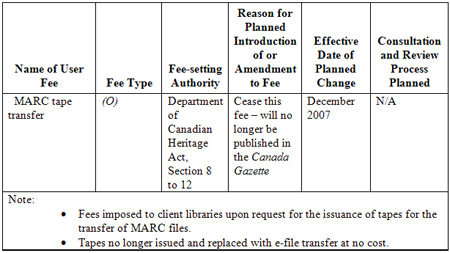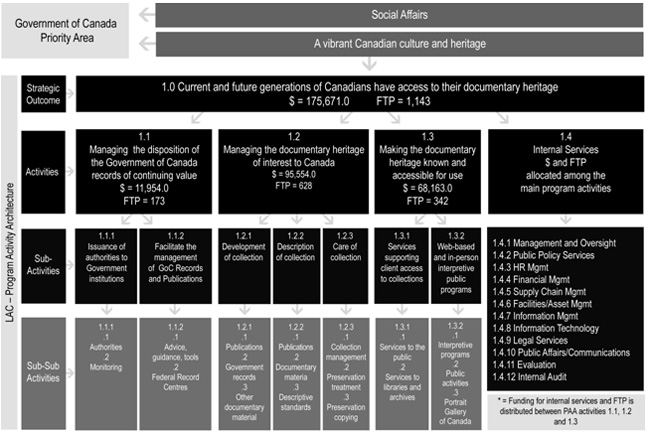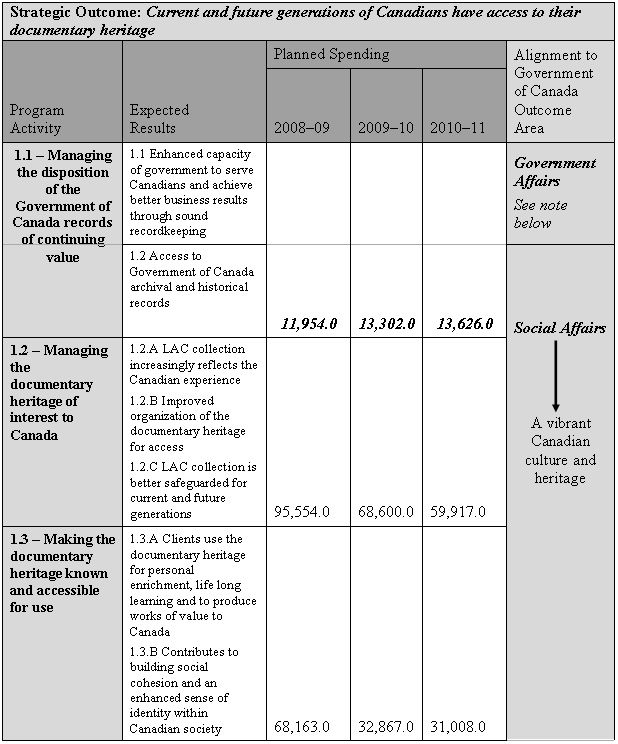ARCHIVED - Library and Archives Canada
 This page has been archived.
This page has been archived.
Archived Content
Information identified as archived on the Web is for reference, research or recordkeeping purposes. It has not been altered or updated after the date of archiving. Web pages that are archived on the Web are not subject to the Government of Canada Web Standards. As per the Communications Policy of the Government of Canada, you can request alternate formats on the "Contact Us" page.
2008-2009
Reports on Plans and Priorities
Library and Archives Canada
The Honourable Josée Verner, P.C., M.P.
Minister of Canadian Heritage, Status of Women and Official Languages
Table of Contents
Message from the Librarian and Archivist of Canada
Management Representation Statement
Mandate of Library and Archives Canada
Section II - Analysis of Program Activities by Strategic Outcome
Section III - Supplementary Information
Section IV - Other items of interest
Legislation Administered by the Librarian and Archivist of Canada
Section I - Overview

Thanks to the contributions of dynamic communities across the country and tremendous creative talent, Canadians have a wonderfully rich and diverse cultural heritage. Canada's unique brand of culture has overcome the challenges posed by our vast geography and has played a critical role in strengthening the Canadian federation. Our creative and innovative society embraces the tremendous possibilities offered by rapidly changing technologies. The Canadian Heritage portfolio organizations work to ensure that the cultural sector is able to take advantage of every opportunity available and that Canadian arts and culture continue to be robust and accessible to people here at home and around the world.
The strategic direction that Library and Archives Canada (LAC) is taking clearly demonstrates this. LAC is using vehicles such as the Internet and television to bring Canada's documentary heritage directly to Canadians, no matter where they live. By digitizing a range of materials from a priceless national collection in all media, LAC is placing items that were once only accessible to some, just a mouse click away for everyone.
Canada's documentary heritage extends to the important government records of the past that describe decisions that continue to shape Canadian life today. LAC is playing a critical role in supporting our Government's commitment to accountability by leading the modernization of government record-keeping policies, practices, and procedures. This is only one part of an ambitious LAC agenda that will gain greater worldwide exposure during the conference of the International Federation of Library Associations and Institutions taking place in Québec City at the height of its 400th anniversary celebrations. There, some 5,000 participants will see Canada's commitment to managing its documentary heritage and making it known through the work of one of the world's most innovative cultural institutions, Library and Archives Canada.
As the work plan outlined in this 2008-09 Report on Plans and Priorities illustrates, Library and Archives Canada will continue to preserve and promote our cultural heritage, which is at the very heart of what it means to be Canadian.
The Honourable Josée Verner, P.C., M.P.
Message from the Librarian and Archivist of Canada
Canada has built a broad, deep, diverse documentary heritage collection. It represents a rich resource that enables Canadians to understand our past and present-and offers a profound legacy for future generations. As its steward and guardian, Library and Archives Canada is constantly building the collection, caring for it and making it known to Canadians and people around the world who are interested in the stories of Canada.
Our work takes place in constantly evolving circumstances. Challenges arise and opportunities present themselves. We have accomplished a great deal in recent years in terms of building a collection with items from Canada's past and the digital information being generated now. We have made our collection more accessible than ever to Canadians no matter where they live. We have led a process to modernize government recordkeeping in order to support improved accountability and more efficient, effective public administration.
Our 2007-2010 business plan is focusing LAC management attention and resources on priorities in becoming the kind of knowledge institution that Canada needs. Under that plan, we are taking full advantage of the new digital information environment. Initiatives such as the Canadian Digital Information Strategy and the Canada Project that are under development now are partnerships putting Canada on track to capture much more of the digital information being produced today, while also supporting the digitization of older material in formats such as print, film, video and audio.
We are continuing to reinforce our leadership role in improving recordkeeping in the Government of Canada, offering expert advice and sharing best practices in a time when government transparency and accountability have become so important and records must be organized, accurate and accessible to meet public expectations. As we address the priorities for action that a government-wide task force of Assistant Deputy Minister-level leaders has identified, we are also seeing a better understanding of the fact that all departments and agencies are accountable for quality in recordkeeping and that we can help them to act on their accountabilities.
The increased awareness of the importance of preserving Canada's documentary heritage and of ensuring that Canadians have access to the collection also draw attention to the challenges of the space needed to accommodate our collection. We are receiving a continually growing number of items for our collection under the Legal Deposit requirements of the Library and Archives of Canada Act and through our many other acquisition and donation processes. We will continue to identify the most appropriate means of housing that collection in ways that reflect its often fragile nature and that also take into account the continually evolving options for storing our rapidly-expanding number of digital items.
Since the creation of Library and Archives Canada in 2004, our organization has made impressive strides in clearly defining our role in a changing information environment, in building and leading partnerships to move forward on priorities in areas such as ensuring the preservation of Canada's digital legacy and developing a government recordkeeping regime that reflects today's needs and opportunities.
My ultimate vision is to have this organization, along with its partners, take the lead in the digitization of all Canadian published works, with complete access to our cultural inheritance, with bilingual content and search capabilities, and with the resources to preserve the enormous range of materials that reflect who we are as Canadians. I picture Library and Archives Canada as a dynamic and digitized source of ideas and debate, an organization that works seamlessly with other libraries and archives to deliver our mandate, and a knowledge institution that allows people to explore our vast heritage wherever they live. The tasks ahead centre on consolidating the progress we have made already and accelerating the work needed to achieve the results that we know we can generate.
In a year in which Canada will welcome an estimated 5,000 participants from around the world to the International Federation of Library Associations and Institutions Conference in Quebec City, Library and Archives Canada is pursuing an innovative approach that is being studied by libraries and archives around the world. This Report on Plans and Priorities offers our commitments and describes our determination to create a knowledge institution that reflects the information world of the 21st century.
Management Representation Statement
I submit for tabling in Parliament, the 2008-2009 Report on Plans and Priorities (RPP) for Library and Archives Canada.
This document has been prepared based on the reporting principles contained in the Guide to the Preparation of Part III of the 2008-09 Estimates: Reports on Plans and Priorities and Departmental Performance Reports:
- It adheres to the specific reporting requirements outlined in the Treasury Board of Canada Secretariat guidance;
- It is based on the department's Strategic Outcome and Program Activity Architecture that were approved by the Treasury Board;
- It presents consistent, comprehensive, balanced and reliable information;
- It provides a basis of accountability for the results achieved with the resources and authorities entrusted to it; and
- It reports finances based on approved planned spending numbers from the Treasury Board of Canada Secretariat.
Ian E. Wilson
Librarian and Archivist of Canada
Mandate of Library and Archives Canada
The preamble of our enabling legislation, the Library and Archives of Canada Act, states that the mandate of Library and Archives Canada is:
- to preserve the documentary heritage of Canada for the benefit of present and future generations;
- to serve as a source of enduring knowledge accessible to all, contributing to the cultural, social and economic advancement of Canada as a free and democratic society;
- to facilitate in Canada cooperation among the communities involved in the acquisition, preservation and diffusion of knowledge; and
- to serve as the continuing memory of the government of Canada and its institutions
Library and Archives Canada (LAC) achieves this mandate through a variety of responsibilities, activities and partnerships that reflect Canadian diversity. Increasingly, we work with the archives, libraries and museums across the country that also hold their own parts of Canada's national collection of cultural materials.
We are constantly building our unparalleled collection of materials of relevance to the story of Canada. The LAC collection includes printed materials, photographs, electronic publications, maps and documentary art such as posters and paintings of people and places. Some acquisitions result from legislated Legal Deposit requirements that require publishers to provide copies of materials published in Canada. Others are acquired from government of Canada departments and agencies and through the purchase or donation of materials.
We catalogue and describe these holdings in accordance with international descriptive standards to make it easier for people to find items. LAC's leadership role in cataloguing and describing materials for the Canadian archival and library communities makes access to the LAC and other collections across Canada simpler and consistent no matter where an item in a collection may be.
By managing the care of our collection, we ensure it is preserved for future generations. Our use of risk management approaches enables us to make the best use of LAC storage facilities as well as our staff expertise in applying preservation treatments and techniques.
The collection is enhanced by our role as the permanent repository of government of Canada records of business or historic value for reference by researchers and the public. We ensure that records are available in response to public requests and to support departmental and government-wide decision-making and accountability. We also examine broad government recordkeeping issues and advise on improvements in recordkeeping to help meet government priorities.
Our mandate within this framework centres on recordkeeping and accessibility. We are continuing to work towards establishing recordkeeping as a regulatory regime of accountability and stewardship within government in which records are created, used, kept and preserved as vital business assets and knowledge resources to support effective decision-making and achieve results for Canadians. A commitment to accessibility informs all LAC activities on policies, strategies and methodologies to make government records more accessible to users.
Government recordkeeping is also the focus of work at LAC Regional Service Centres in eight cities, where records in all media are managed on behalf of more than 90 federal government departments and agencies. This extends from taking in records of continuing value from government institutions, including personnel records, storing and protecting them and retrieving those required for reference or research. As part of this, we segregate archival and historical records that are designated for permanent preservation, and destroy the others when no longer required. Centres also hold backup copies of electronic records that are deemed essential, in the event of disaster or emergency, to the operations of government and the protection of rights.
We seek to make our entire collection known in many ways to Canadians and people interested in Canada. For example, our client services help users understand how our collection and resources are organized and assist them to find items of interest and relevance. As necessary, we safeguard the rights attached to all holdings. This can involve investigating copyrights, ensuring privacy protection or providing rights clearances. It includes dealing with more than 20,000 requests annually that spur reviews of archival records, of personnel records of former civilian and military government employees, and LAC's operational records.
Library and Archives Canada reaches out to Canadians through exhibitions, learning opportunities, public programming and a rich website, including those within the Portrait Gallery initiative. In Canada's National Capital Region, LAC stages this programming at our Ottawa and Gatineau locations and at partner venues. Canadians living elsewhere make contact with Canada's documentary heritage through our ever-expanding website, travelling exhibitions and special events, many involving collaboration with diverse partners.
LAC makes our collections available through resource-sharing services that include inter-agency borrowing/lending, document delivery and collaborative reference, as well as our work in partnership with the Canadian library community on the infrastructure that supports resource sharing. Within the federal government, this is matched by our coordination of the library services of federal departments and agencies to achieve excellence and to encourage the effective management of human and financial resources.
Canada Welcomes the Library World to Quebec City in 2008
Canada will host the 74th conference of the International Federation of Library Associations and Institutions (IFLA) in Quebec City in August 2008. IFLA 2008 will attract between 4,000 and 5,000 participants from 150 countries as Canada celebrates the 400th anniversary of the founding of Quebec City.
With its theme "Libraries without borders: Navigating towards global understanding," IFLA 2008 will draw attention to the mission and future of libraries in a world that is undergoing profound change.
Canada hosting IFLA 2008 represents an opportunity for Library and Archives Canada to demonstrate leadership within the international library community, consistent with the innovative directions that LAC is taking. It is also a chance to underline to Canadians the importance of documentary heritage and its management by LAC as well as how LAC collaborates with government departments and agencies. Library and Archives Canada has been working very closely with Bibliothèque et Archives nationales du Québec and the organizing committee to ensure the success of this conference.
Library and Archives Canada Program Activity Architecture
Accountability for results for the program activities is allocated as follows:
Program activity 1.1 - Assistant Deputy Minister, Corporate Management and Government Records
Program activity 1.2 - Assistant Deputy Minister, Documentary Heritage Collection
Program activity 1.3 - Assistant Deputy Minister, Programs and Services
Program activity 1.4 - Assistant Deputy Minister, Corporate Management and Government Records / Director General, Strategic Office / Director General, Communications / Director General and Chief Technology Officer, Information Technology Services
Library and Archives Canada Organization Chart
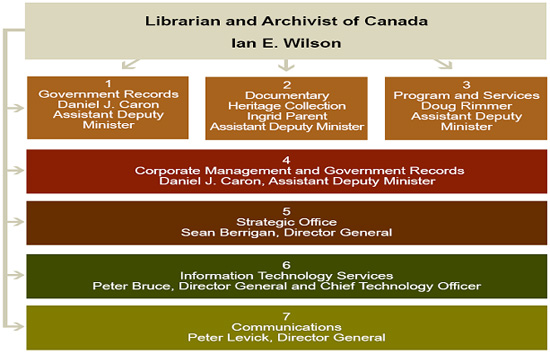
Voted and Statutory Items displayed in the Main Estimates

Departmental Planned Spending Table
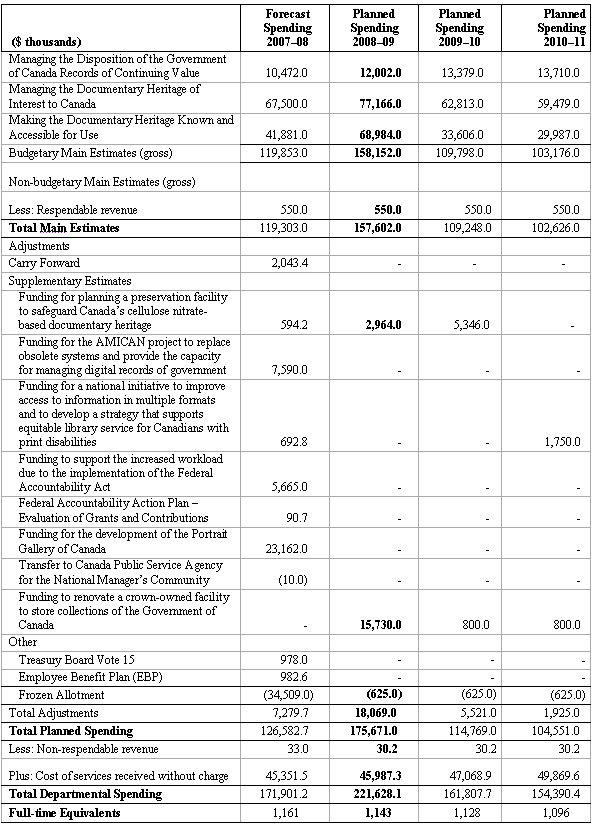
Planned spending decreases over the three year planning period due to sunsetting of capital project initiatives, which includes the construction of an Interim Collection Facility, a Nitrate Preservation Facility, and the Portrait Gallery of Canada. Capital related expenditures accounts for approximately 34 percent of planned spending in 2008-2009 and 5 percent in 2009-2010. Operating related expenditures accounts for approximately 65 percent of planned expenditures in 2008-09, and the following two years are 93 percent and 98 percent, respectively.
Summary Information
Financial Resources ($ thousands)
| 2008-09 | 2009-10 | 2010-11 |
|---|---|---|
| $175,671.0 | $114,769.0 | $104,551.0 |
Human Resources
| 2008-09 | 2009-10 | 2010-11 |
|---|---|---|
| 1,143 | 1,143 | 1,143 |
Strategic Choices (Departmental Priorities)
In 2006, Library and Archives Canada employees worked together to assess the environment in which LAC is working and will be working in the years to come. They examined the opportunities and risks in the organization's environment. That process led to the identification of five Strategic Choices, each of which represents a LAC priority for change above and beyond the ongoing activities described earlier under the Mandate of Library and Archives Canada. Those five Strategic Choices, which have implications for all four LAC program activities, are all ongoing activities. They are:
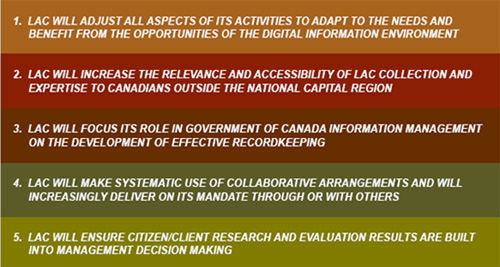
Program Activities by Strategic Outcome
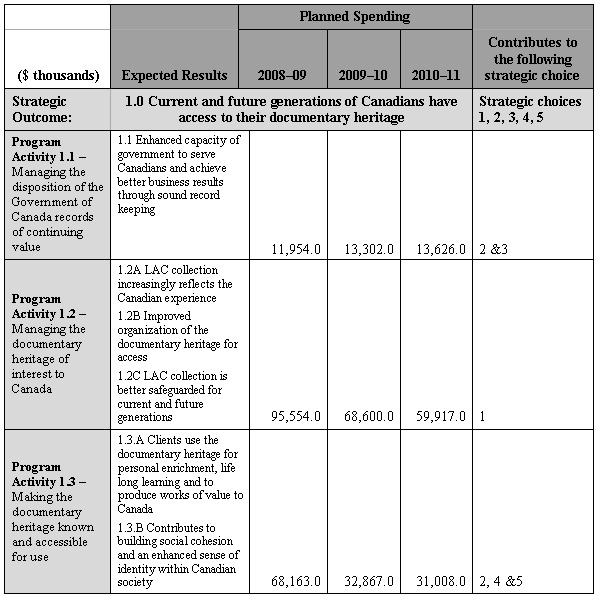
Risks to be Mitigated
Key Risk: Preservation of digital and analog documentary heritage
The risk, for LAC, of not being able to assume all of its responsibilities in terms of the preservation and access to documentary heritage in electronic and analog format, due to lack of the appropriate financial, human and technological resources, or a lack of appropriate partners.
Key Risk: Long-term accommodation and technological infrastructure
The risk, for LAC, of not being able to assume all of its long-term responsibilities in terms of the preservation and access to documentary heritage under its care, due to a lack of appropriate material and technological infrastructure.
Key Risk: Financial Sustainability
The risk, for LAC, of a lack of resources or budget to ensure its core activities or the establishment of the necessary conditions to meet its growing obligations.
Key Risk: Availability and competency of human resources
The risk, for LAC, of not being up to ensuring the transmission of its institutional knowledge to its new generations of employees or not being able to recruit or renew its human capital with staff that have the appropriate knowledge and skills.
Key Risk: Government-wide Initiatives
The risk for LAC is, on one hand, allocating the financial and human resources it must devote to government-wide initiatives and, on the other hand, allocating the resources it must reserve for its activities, in accordance with its mandate and delegated authorities.
Identifying the Five Strategic Choices
The business planning process in 2006 led to the identification of five Strategic Choices, above and beyond LAC's ongoing commitments. Moving ahead on all five choices requires a rebalancing of how LAC has been using its resources and a rethinking of activities. For each strategic choice, we identified intermediate outcomes and a comprehensive set of actions designed to accelerate and focus progress toward those outcomes. Below are the high-level results and implementation strategy. The major actions are described in Section II of this Report.
Strategic Choice 1
LAC will adjust all aspects of its activities to adapt to the needs and benefit from the opportunities of the digital information environment
Expected High-Level Results:
- Digital documentary heritage is acquired and preserved for future generations;
- In their homes, offices or anywhere with hand held devices, Canadians have more timely and convenient access to their documentary heritage;
- LAC makes efficient and effective use of IT in all of its business activities.
Overview of the Implementation Strategy
We will extend our efforts and increase our investments in acquiring and preserving Canada's digital documentary heritage, and in making use of digital technologies-both to improve access and awareness and to rethink our business processes and operations. We will reach this objective through the development of the Canadian Digital Information Strategy (CDIS), a comprehensive digital
asset framework that will support fully automated ingest, preservation and access to digital documentary heritage. We will initiate the Canada Project which will increase our rate of digital acquisition to deal effectively with the annual production of documentary heritage; we will develop functional specifications for digital recordkeeping in government. LAC will also begin working
with partners to build a national network of Trusted Digital Repositories.
LAC will work towards integrated access to our collection by means of a website that is user-friendly, dynamic and interactive. LAC will digitize for use and for preservation and will steadily build the volume of documentary heritage available on our website. LAC will systematically rethink the services we deliver, both to content creators and to content users, and the way in which we do business in order to respond to the demands and maximize opportunities of the digital environment.
This strategic choice will enable us to mitigate the risks associated with the preservation of Canada's digital documentary heritage. It will also be a means of allocating resources in line with achieving financial sustainability and will guide long-term accommodation infrastructure choices.
Strategic Choice 2
LAC will increase the relevance of and accessibility to the LAC collection and the expertise to Canadians outside the National Capital Region (NCR)
Expected High-Level Result
- Canadians outside the NCR have improved access to LAC programs and services relevant to their needs.
Overview of the Implementation Strategy
In order to deliver the documentary heritage of Canada to Canadians beyond the NCR, LAC will focus on activities that demonstrate the relevance and increase the accessibility to our collections. This shift in service horizon will build on a market segmentation of current and potential clientele to identify particular needs and interests. LAC will increase the relevance of and
accessibility to our collections by increasing digital access and content and by working both with organizations who share custody of Canada's documentary heritage and with targeted groups such as genealogists, multicultural communities and teachers. LAC will rely on the expertise of our staff both to improve access and to develop content relevant to Canadians in all regions.
Strategic Choice 3
LAC will focus its role in Government of Canada information management on the development of effective recordkeeping
Expected High-Level Result:
- Government of Canada institutions demonstrate the capacity to create, use and preserve records of long-term value as reliable evidence of business decisions, activities and transactions.
Overview of the Implementation Strategy
The capacity of federal agencies to operate effectively is affected by their challenges in all areas of managing records of business value. LAC will therefore focus our role in government information management on the development of a Recordkeeping Regulatory Regime that will facilitate accountability and stewardship in the creation, use, management and preservation of records as
vital business assets and knowledge resources to support effective decision making, policy development, and the delivery of programs and services to Canadians. We will also assist the government of Canada in ensuring the accessibility of its records of on-going business value.
This strategic choice will enable us to mitigate the risks associated with responding to the government agenda and new projects, as this is likely to be a major continuing focus for government. As well, a clarified emphasis on recordkeeping will help to better define long-term accommodation infrastructure needs, in keeping with the related commitment to financial sustainability.
Strategic Choice 4
LAC will make systematic use of collaborative arrangements and will increasingly deliver on its mandate through or with others
High-Level Result
- The LAC program is more efficiently and effectively delivered through extensive use of partnerships with others.
Overview of the Implementation Strategy
LAC will move from being opportunistic to being more strategic, enduring and sustainable in our partnership practices. We will systematically and comprehensively use collaborative arrangements as a means of delivering on our mandate. LAC can benefit from the synergy and more effective results of working with or through others. The model for this new way of doing business is evident on
the Web. Distributed networks permit a variety of institutions to make contributions based on their strength and capacity. By working together, institutions can realize economies of scale, improve service levels and maximize investments in information and communications technologies and in professional expertise.
In order to achieve this strategic choice, LAC will have to realize a major cultural change. We will shift attitudes from a focus on "doing" to a focus on collaborating or enabling. We will need to develop the necessary capacity and infrastructure to negotiate and manage a wide range of partnerships. LAC will actively seek opportunities to deliver on our mandate by working with or through others.
This strategic choice will enable us to mitigate all our significant risks as it will enable a more appropriate sharing of costs and benefits among partners, with impacts on infrastructure, finances and human resources. It will also provide an approach to addressing the risks related to the preservation of Canada's digital documentary heritage through sharing responsibilities.
Strategic Choice 5
LAC will ensure citizen/client research and evaluation results are built into management decision making
Expected High-Level Results:
- Canadians' need for documentary heritage is understood and acted on in the planning and delivery of the LAC mandate;
- An integrated LAC approach provides federal departments the seamless access to the products and services they require.
Overview of the Implementation Strategy
As LAC moves beyond providing well-established services to a traditional clientele, the institution requires a user research and evaluation capacity. The quantitative and qualitative evidence provided by such research will be a key contributor to effective decision making. User research and evaluation will be critical in enabling LAC to identify Canadians' changing needs and to serve
new markets, as well as to meet our accountability requirements as a federal department.
This strategic choice will enable us to mitigate most significant LAC risks as it will ensure that choices are being made on the basis of clear guidance from target audiences and more comprehensive learning from the evaluation of actions previously taken.
The Canadian Digital Information Strategy and the Canada Project
Individual Canadians and Canadian businesses, governments and non-profit organizations create, use and store massive amounts of electronic records and documentation of many kinds each day. In 2006, the amount of digital information created, captured and replicated was about three million times the information in all the books ever written.
Preserving these digital assets and content is a significant challenge for institutions and organizations throughout the world. Enormous amounts of digital information have already been lost forever. The Canadian Digital Information Strategy, developed by LAC through consultations with a wide range of partners and described later in this RPP, recognized the need to preserve Canada's documentary heritage, whether digital or in any other format, through digital tools.
The Canada Project, a large scale digitization project, which is taking shape now, responds to this need through a broad partnership of academic, public, private and non-profit organizations. Its goal is to digitize and preserve Canada's documentary heritage in a phased approach and make it available online in both of Canada's official languages. It will be organized based on principles of open collaboration, while respecting copyright. It will reflect Canada's linguistic duality and cultural diversity and ensure long-term access for future generations using international digital preservation standards.
The collection of digital information and digitization of information now found in books, other published materials, photographs, documentary art, film, sound recording and other media would be an effort involving multiple partners across Canada. It would be supported by an infrastructure to receive these assets, organize them and make them available to users in Canada and around the world, much of which is described in this RPP through initiatives such as the creation of Trusted Digital Repositories and the implementation of the Virtual Loading Dock. It would open new commercial and research opportunities to Canadians.
In 2008-2009, LAC expects to finalize of the Canadian Digital Information Strategy and to further develop the Canada Project for positioning Canada as a leader in the digital world.
Section II - Analysis of Program Activities by Strategic Outcome
Analysis by Program Activity
1.0 - Current and future generations of Canadians have access to their documentary heritage
Effective with the 2006-2007 fiscal year, Library and Archives Canada (LAC) began to focus planning and reporting to Parliament and the central agencies of the Government of Canada through the achievement of a single strategic outcome.
Within that strategic outcome we identified four program activities that encompass the range of activities under the mandate that Parliament set out through the Library and Archives of Canada Act. The three program activities that involve services to Canadians and to Government of Canada organizations are described on the following pages. Each program activity discussion centres on the major initiatives linked to progress on the five strategic choices. The fourth program activity, Internal Services, is described in Section IV of this Report.
One impact of the creation of the Library and Archives Canada Business Plan 2007-2010 is a current reassessment of performance measurement in the organization.
Performance measures are being developed to reflect the directions set out by the Strategic Choices and that will be consistent with the LAC Program Activity Architecture. As a result, many measures in this RPP do not yet include well-defined quantitative and qualitative targets relative to established baselines.
Program Activity 1.1 - Managing the disposition of the Government of Canada records of continuing value
Financial Resources
| 2008-09 | 2009-10 | 2010-11 |
|---|---|---|
| $11,954.0 | $13,302.0 | $13,626.0 |
Human Resources
| 2008-09 | 2009-10 | 2010-11 |
|---|---|---|
| 173 FTE | 173 FTE | 173 FTE |
Description of Program Activity: Through the issuance of Records Disposition Authorities, the development of record-keeping advice, tools and guidance, and the provision of Regional Service Centre services for departments of the Government of Canada, LAC enables and facilitates the management of information within federal agencies and ensures that government's archival and historical records are identified and appropriately preserved.
Key Commitment in Support of Strategic Choices
This program activity corresponds particularly to Strategic Choice 3, which seeks to reinforce the role that LAC plays in government of Canada information management by focusing on supporting improved recordkeeping across the government. It responds to the current reality that federal agencies generate massive amounts of business records but face serious challenges in managing those records that have ongoing business value. Those challenges mean that, for example, too much information of no ongoing value is being stored at significant financial cost and it can be difficult to find particular records promptly when they are needed, as is the case for Access to Information requests.
Accordingly, improvements in government recordkeeping are recognized as a priority in enhancing accountability throughout the government of Canada. In 2006, we initiated a process with the Privy Council Office to hold Deputy Minister (DM) Roundtable sessions on government recordkeeping and information management. The Roundtables were co-chaired by the Librarian and Archivist of Canada and the government's Chief Information Officer. Deputy Ministers agreed that the government of Canada needed to address recordkeeping issues "head on" and asked LAC, in collaboration with departments and agencies to lead the development of a program of change that would support government executives in their efforts to enable an effective national public administration partly by returning recordkeeping to the status of a core public service value.
A subsequent ADM Taskforce on Recordkeeping has led to recommendations on the design of the overall recordkeeping program of change. The intent is to clarify and implement a new recordkeeping regulatory regime in the government of Canada that would address issues such as risk, capacity, legacy records and electronic records. This new regime would have significant impacts on all federal departments and agencies and on LAC.
LAC has identified four areas of major attention in 2008-2009 and beyond that will contribute to moving this new regime forward.
- The active support of federal departments and agencies that will have to make significant changes to their own recordkeeping practices is a critical risk. LAC will pursue communication strategies to make clear the benefits of the new regime and will enlist support by involvement in projects designed to test recordkeeping improvements. LAC also anticipates continued support from Deputy Ministers and Central Agencies.
- Funding by LAC and by departments and agencies will be needed to pursue projects and implement recordkeeping changes. It is expected that clarity on the benefits to be achieved will lead to funding being made available.
- Capacity in areas such as staff expertise will be important to develop to support specific projects testing elements of the new recordkeeping regime and in implementing the substantial changes expected. This will take place through ongoing training and awareness building.
Continue to Develop the Ongoing Government Records Program and Record Disposition Agreements with Federal Institutions
LAC has an ongoing responsibility to work with clients and partners across government on archival and recordkeeping issues. This will continue to take place to address immediate situations, such as negotiations for the Records Disposition Authorities with federal departments and agencies that govern the transfer of records of historical or archival value to LAC. The pace of those negotiations is normally driven by partner department and agency considerations beyond the control of LAC.
Our major priority in support of the LAC Strategic Choices is to obtain the support of partner departments and agencies for the new and innovative recordkeeping solutions that we are developing and expect to implement under the regulatory regime that is taking shape. In particular, we intend to implement a recordkeeping standard and a delegation authority tool that will reflect the new regime. To gain the support of federal institutions for the substantial changes necessary to more effectively manage records, we will pursue a communication strategy. This direction will also be supported by progress on the other commitments made under this program activity.
Performance Measures:
Short term
- Number of Records Disposition Authorities finalized
- Progress in implementation of new recordkeeping regime (including standards and delegations of authority)
Long term
- Number of departments and agencies implementing the new recordkeeping regime
- Time required to issue a Records Disposition Authority
- Percentage of departments satisfied with LAC key recordkeeping regime products and activities
Assessment Projects to Improve Government Recordkeeping
Because of the scale of change expected under the new recordkeeping regime, a series of assessment projects have been developed to test the assumptions, or otherwise prove the concepts, underlying proposed recordkeeping improvements. The projects test ways to streamline processes, identify efficiencies, reduce records-related risks across government in relation to issues such as litigation and security, and address cost recordkeeping cost pressures.
Recordkeeping situations differ widely across the government and the projected new recordkeeping regime will need to reflect that reality. Therefore, projects that initially prove successful will often be expanded to a broader range of departments and agencies until we can identify transferable results applicable across the government. The projects also will give us a clear sense of the funding needed to implement the new recordkeeping regime as well as implementation issues to be addressed.
Performance Measures:
Short term
- Assessment project results and the findings analyzed, with lessons learned and best practices identified
- Development of a plan for full implementation of the new recordkeeping regime, drawing on assessment project results
Long term
- Percentage of institutions using LAC tools under a new recordkeeping regime
Implement the New Storage Model (NSM) for Government Records
In 2005-2006, we began our New Storage Model project. We expect to have this Model and its supporting action plan finalized with implementation beginning in 2008-2009. It should provide for secure, accessible and cost-effective storage in appropriate environmental conditions for government of Canada records of business value in all media. The focus on storing only records of business value will enable us to meet our commitment to generate savings across the government through more effective and efficient records storage.
Performance Measures:
Short term
- Implementation of the NSM action plan will be taking place
Long term
- The action plan will be fully implemented by 2012
Move Forward on the Accessibility Initiative
Library and Archives Canada has a large volume of records received over time from federal departments and agencies. Many of these records realistically have no business value that would merit retention. Identifying records with no business value that can be destroyed would reduce storage and administrative costs for records currently held and would enable departments to better identify records to be kept or destroyed under the Records Disposition Authorities described earlier in this section, so those are never held by LAC.
An Accessibility Working Group analyzed issues related to ensuring access to government records. It proposed a three-year action plan to produce better descriptive information on government records, support records digitization, reduce review requirements in relation to Access to Information and Privacy situations and reduce LAC's storage, circulation, and preservation requirements.
A key step forward will be our "Clearing the Path" initiative that will use a targeted approach to identify and then eliminate non-archival records, and in the process provide clearer information on the remaining records of archival value. It will focus on the eight government institutions responsible for 66 percent of records transfers to LAC.
Over time, we expect our accessibility action plan will lead LAC and federal institutions to improved mechanisms for acquiring and describing archival records in all media to make them more accessible to Canadians. We expect to measure success by more efficient workflows, improved intellectual control and enhanced services to clients in the government of Canada and the Canadian public.
Performance Measures:
Short term
- Continue the "Clearing the Path" initiative, which will result in reduced storage demands for LAC and guidance for the development of new Records Disposition Authorities, applications guides and future advice to the government of Canada.
- Begin the accessibility action plan implementation
Long term
- Departments and agencies will know what records are likely to be of archival value and will only send those to LAC
- Existing LAC holdings will be confined to records of business value
- Archival records transferred to LAC will be more accessible in accordance with established service standards
Program Activity 1.2 - Managing the documentary heritage of interest to Canada
Financial Resources
| 2008-09 | 2009-10 | 2010-11 |
|---|---|---|
| $95,554.0 | $68,600.0 | $59,917.0 |
Human Resources
| 2008-09 | 2009-10 | 2010-11 |
|---|---|---|
| 628 FTE | 628 FTE | 628 FTE |
Description of Program Activity: The building of a national documentary resource for all aspects of the study of Canada is fundamental to the mandate of Library and Archives Canada. The Library and Archives Canada collection consists of published and unpublished materials in a variety of formats acquired through Legal Deposit, agreements with government institutions and selected private materials purchased or received by donation. To access the contents of collections, they must be described. Description can take many forms and provide various layers of access but is governed by nationally and internationally accepted codes of practice. At the same time, holdings are also described to meet Canadians' expectations for timely and equitable access. Once materials enter the LAC collection they are managed to ensure their long-term preservation and accessibility through policies, procedures and various programs including storage, conservation, restoration and copying. To fulfill its role as a permanent repository of government records and publications, Library and Archives Canada enters into agreements with government institutions to ensure that documents of historical and archival value are eventually transferred to LAC. LAC also provides advice to assist government institutions in fulfilling their obligations under Sections 12 and 13 of the Library and Archives of Canada Act.
Key Commitment in Support of Strategic Choices
This program activity is now being particularly influenced by the commitments inherent in Strategic Choice 1, which seeks to ensure that LAC becomes a knowledge institution that benefits from the digital information environment. It is also influenced by the need to build and care for a collection that we want to be relevant to all Canadians in a country of great diversity. In recent years, LAC has begun to identify proactive approaches to how it wants to build its collection and its priorities in caring for that collection.
In practice, this has meant creating strategic frameworks such as Collection Development Framework that is guiding choices in what kinds of acquisitions to make. It is also being supported by the Metadata Framework for Resource Discovery which sets out key principles by which publications and records are described for access and use by Canadians.
LAC has identified two areas of major attention in 2008-2009 and beyond, which are to develop strategies for preserving documentary heritage and in collecting documentary heritage in digital format. Both will contribute to managing our collection in line with the opportunities and benefits of the digital information environment and more broadly ensure a relevant and accessible collection to Canadians and people around the world interested in Canada's documentary heritage. They will both draw on our expanding partnerships with other organizations that share our commitment to preserve Canada's documentary heritage.
- Contribution from and engagement of many partners is critical to success in many of the initiatives described under this program activity. In many cases, partners need to allocate some of their own funds. LAC will continue to consult widely to ensure that the interests of other partners are taken into account and that they can see and demonstrate the clear value of these initiatives to their own operations.
- Funding issues will be very important since many initiatives are only partially funded or have only short-term funding commitments. Funds will be aligned with areas of greatest potential impact and that offer the best strategic opportunities to achieve LAC and partner goals. LAC will monitor spending closely to ensure that expected results are on track, given available funding.
- Shifts of existing funding away from ongoing responsibilities to support new or expanded activities will have to be managed to minimize negative impacts on ongoing or expected commitments.
- Technical and technological capacity will need to be in place to support the expected levels of digital information capture and management as well as the extensive plans to digitize information in other formats now. This will be a focus on ongoing management attention as technologies continue to evolve rapidly.
- Human resources within LAC represent another capacity issue. In many cases, initiatives involve skill sets that may vary from those traditionally held by the LAC staff who are most likely to be engaged. The organization anticipates a need to ensure that the appropriate learning infrastructure is in place so staff have the requisite skills and knowledge.
Developing strategies for preserving documentary heritage
With underlying frameworks in place to guide LAC choices and actions, we have moved on to identify specific areas in which we need to better define our business needs and reinforce how we manage our collection. In a number of cases, we have begun or plan to begin pilot projects to test approaches that we believe will increase our capacity to manage all aspects of archival records in an increasingly digital environment.
Performance Measures:
The short-term performance measures are noted under each element below. They are expected to combine and complement each other to achieve the following long-term performance measures.
Long term
- LAC and its partners consistently and effectively collect, manage and care for Canada's digital documentary heritage.
- LAC develops its collection in an integrated manner and according to overall institutional priorities, including reflecting the Canadian experience.
- Modernized approaches to resource description and discovery, including national resource description standards, will be in use by LAC and in use widely among Canadian knowledge institutions
- Canadians will have better access to more of Canada's documentary heritage resources through new or improved national resource discovery database networks and research tools.
- Parts of the collection known to be most at risk, particularly due to the technology formats in which they exist, are addressed as priorities for preservation.
- A strategic, large-scale digitization program in LAC and elsewhere enables expanded access to Canada's documentary heritage, regardless of its original format and uses consistent resource description approaches for our holdings.
Develop a Canadian Digital Information Strategy
Library and Archives Canada has been leading a process to create a pan-Canadian strategy to build Canada's capacity to produce high-quality digital information resources, to digitize key parts of its documentary heritage that are not in digital forms now (e.g., printed material and materials in formats such as audio and video) and to preserve for future use information produced in digital form.
We have been working closely with partners such as libraries, archives, museums, data centres, publishers, producers, distributors, rights organizations and academia because all partners will have complementary roles in a national strategy for digital information production, preservation and access based on a collaborative, decentralized approach.
Performance Measures:
Short term
- A strategy for digitization and preservation of Canadian documentary heritage is in place
- Partnerships are in place
Web Archiving Strategy
Library and Archives Canada has reallocated internal resources to support the archiving of federal and provincial government websites and those of elections authorities. The process for each harvest of the Government of Canada Web domain takes five months and, on average, gathers the equivalent of the information that would fill 2,000 sets of encyclopaedias.
In 2008-2009, we will implement a Web Archiving Strategy to guide our expansion of this harvesting to other domains, which will guide a new Web Archiving Program that will begin in 2009-2010. That strategy will set out the parameters we will use to decide which websites to archive, supported by clear selection and preservation guidelines. It will include approaches to address access and copyright issues related to content not under the public domain.
Performance Measures:
Short term:
- A collection strategy for websites exists including all necessary operational guidelines
- Processes to address access and copyright issues are in place
- Targets are set for the number and types of websites to be harvested
Develop and Implement a Resource Discovery Strategy
In addition to acquiring and preserving the documentary heritage of Canada, LAC is responsible for organizing and making that heritage known and facilitating access to it. Resource discovery refers to the set of processes and tools by which LAC's clients identify, find, retrieve and use our collection. The LAC Metadata Framework for Resource Discovery provides a policy framework for the creation and management of metadata supporting resource discovery. In 2008-2009, we will develop a Resource Discovery Strategy to align and focus our resource description and related activities, which will then be tested through pilot projects, which will include:
- Integrated subject indexing of unpublished and published material;
- Linking LAC database records to external websites or pages;
- Acquiring metadata describing LAC holdings from clients and stakeholders; and
- Semantic analysis of Web resources.
We also intend to review our national database networks program and begin to make necessary improvements to components such as the National Union Catalogue and Archives Canada, which will take place over a three to five year implementation timeframe.
LAC will continue to provide leadership, expertise and coordination in the development of national and international resource description standards that are critical to resource discovery, including RDA: Resource Description and Access and the Rules for Archival Description.
Performance Measures:
Short term:
- Development of a Resource Discovery Strategy during 2008-2009.
- Development of a plan for LAC's national database networks program.
LAC Collection Content Strategy
To preserve the documentary heritage of Canada, LAC must define that heritage and its role in the context of a national network of allied institutions and articulate strategies for safeguarding Canada's documentary heritage. Defining our Collection Content Strategy is a key element in this direction. The strategy, which will be developed throughout 2008-2009, will be a policy document informing decisions on what LAC collects and why-as well as on why it does not collect other materials. The strategy will enhance program effectiveness by developing our capability to identify gaps and overlaps in collecting objectives and practices at LAC.
Performance Measures:
Short term:
- By April 2008, sectors within LAC will have defined their acquisition priorities up to 2010.
Audio Visual Preservation
The LAC collection includes hundreds of thousands of hours of audio, video and film. Many items are in formats for which equipment is no longer manufactured and parts are scarce. These items need to be copied to a new preservation format to ensure accessibility. As LAC provides timely and responsive services to meet client expectations, copies are generated for the parts of the collection that are most in demand, but not necessarily the items most at risk. Accordingly, we intend to develop a migration plan and pilot technology that would allow us to make electronic file formats our preservation copy. This strategy will prioritize the migration of various formats, taking into account obsolescence, physical or chemical instability, historical value, and available equipment and expertise.
Performance Measures:
Short term:
- By March 31, 2009, LAC will have a migration strategy for audio-visual and other technology-dependent materials in our collection with priorities set.
Collecting Documentary Heritage in Digital Form
LAC has traditionally been able to collect documentary heritage in a wide range of non-digital forms such as print, audio, film, photographs, art and other media. In a world where so much information is now "born digital," we know that we must be equally adept in collecting Canada's digital documentary heritage. Beyond the overall strategic approaches that we described under the previous major commitment, we will move forward on series of initiatives that involve introducing the tools that will enable us to build our digital collection.
Performance Measures:
The short-term performance measures are noted under each element below. They are expected to combine and complement each other to achieve the following long-term performance measures.
Long term
- A network of Trusted Digital Repositories, supported by standards, policies, tools and infrastructure, exist in Canada to collect, manage and care for Canada's digital documentary heritage securely and effectively.
- LAC will be able to process digital acquisitions with the support of automated tools such as the Virtual Loading Dock, enabling much more rapid and efficient transfer by publishers and donors as well as more rapid and efficient LAC processing once acquisitions are in the collection.
- LAC will have a comprehensive management information system with which to track all aspects of the management of the collection and support automated public access to services.
- LAC is digitizing a continually rising proportion of its collection both to improve public access to the collection and to address issues related to access to fragile materials and materials in formats that require the support of obsolete technologies.
Continue the Development and Implementation of the Trusted Digital Repository Project
LAC has a legislated obligation to acquire and preserve more of Canada's rapidly growing volume of digital documentary heritage. We intend to act on this obligation through the development of Trusted Digital Repository (TDR) services. A TDR provides a framework, systems and tools to manage reliable, long-term access to digital resources. It is organized to address typical challenges such as the volatile nature of digital objects and the change in the information technologies used to create and access them. Our leadership in supporting the creation of a network of TDRs in Canada and ensuring that they all meet consistent standards, will enable libraries, archives, museums and public institutions across Canada to receive and manage these digital assets, making them easily accessible to all users.
During 2008-2009, LAC will continue to develop the standards, policies, guidelines and supports that will bring the TDR concept into being in Canada. We will also move forward with the first TDR module, the "Virtual Loading Dock" (VLD), which will enable publishers, creators, government departments and donors to transfer to LAC their electronic publications, records and other digital assets. It will be supported by a preservation policy and technical infrastructure as well as the supports needed to ensure that people can find and use those digital resources.
The VLD will be particularly important in moving forward efficiently on the Library and Archives of Canada Act requirement that publishers deposit their electronic publications with LAC. It will provide an automated vehicle through which publishers can comply with that requirement more efficiently for themselves and LAC, regardless of medium or file format and using numerous transfer mechanisms.
Performance Measures:
Short term
- Annual acquisitions of electronic publications that are expected to triple from 3,000 to 9,000
- A Digital Repository Services and Standards Office will be in place in May 2008
- A digital preservation policy and guidelines will be in place by September 2008
- A digital toolkit framework (standards and protocols which are key to digital preservation activities) will be established by August 2008
- A TDR architectural roadmap will address content and functionality issues by May 2008
- More depositors, government departments and donors will work with us, including through the legal deposit of digital documents
Continue the Development and Implementation of AMICAN
AMICAN is an information management system that will, among other things, provide a single point of access to the LAC collection for Canadians, and go well beyond the old systems that were used by our two predecessor organizations. As such, it is equally relevant to this program activity and to program activity 1.3, "Making the documentary heritage known and accessible for use."
We are building AMICAN over a three-year period that began in 2007-2008 to 2009-2010. We have already achieved some milestones such as a Federated Search function that includes a specific Ancestors Search capability for genealogy clients and the initial implementation of an Information Holdings Management System (IHMS) at our Ottawa Regional Service Centre.
We plan the following work in 2008-2009 and 2009-2010:
- Develop and implement new elements for a circulation and physical control system for published material, a preservation module for archival material, and preservation module for published material.
- Continued implementation of IHMS in other Regional Service Centres and development of modules for circulation and client interface.
- Develop and implement online services such as client registration for a user card and online ordering of material for consultation.
- Further development of Federated Search to include additional databases and updating of product used.
- Continued implementation of a system to manage client data in LAC.
- Develop and implement an integrated library system (ILS) to replace the current acquisition, cataloguing and serials control of published material, using a build/buy solution.
Performance Measures:
Short term
- Implementation of the AMICAN module indicated above.
Mass Digitization
In recent years, LAC has relied heavily on external partners and funding from the Department of Canadian Heritage to digitize items from our collection and to create web products. We have decided to begin an internal mass digitization program to go much further in this direction with a focus on increased access, supported by internal reallocations of short-term resources.
Performance Measures:
Short term
- Strategic digitization plan is implemented with a goal of digitizing one million images in 2008-09.
Continue efforts to develop capacity in digital archival records
LAC's commitment to adapt to the needs and benefit from the opportunities of the digital information environment calls for a comprehensive program to support acquisition, preservation and access to digital documentary heritage. Work has begun on developing a digital records program to support LAC acquisition of private sector digital records and deal with the backlog of unprocessed acquisitions, out-of-date procedures and other challenges.
Performance Measures:
Short term
- The current backlog of digital records that LAC has acquired but not processed will be reduced steadily
- Digital records management advice will be developed for use with potential donors
Program Activity 1.3 - Making the documentary heritage known and accessible for use
Financial Resources
| 2008-09 | 2009-10 | 2010-11 |
|---|---|---|
| $68,163.0 | $32,867.0 | $31,008.0 |
Human Resources
| 2008-09 | 2009-10 | 2010-11 |
|---|---|---|
| 342 FTE | 342 FTE | 342 FTE |
Description of Program Activity: All materials that become part of the LAC collection are intended for use by those interested in Canada. LAC provides information and services including consultation, research and lending, across multiple channels to facilitate access to the documentary heritage to a wide variety of clients. It also establishes programs, such as the Portrait Gallery of Canada, and encourages or organizes programs such as exhibitions, publications and performances, to make known and interpret our documentary heritage. LAC also provides information resources and standards such as the national catalogue and supports the infrastructure necessary to ensure its accessibility to those interested in Canada.
Key Commitment in Support of Strategic Choices
The initiatives under this program activity are critical to progress on Strategic Choice 1, because digitally supported processes and tools are essential to delivering services now. The use of digital means for reaching out to Canadians is a key aspect in making progress toward Strategic Choice 2, as our organization makes the collection and our expertise more accessible to Canadians outside the National Capital Region. As well, we will be using collaborative arrangements with others to deliver on our mandate, in keeping with Strategic Choice 4. In all our work under this program activity, we will draw on the available information to meet our commitment under Strategic Choice 5 that we built citizen/client research and evaluation results into our decision making so that our programs and services are in line with the interests and preferences of Canadians.
These initiatives will build on our ongoing activities. Many are in support of cultural programs in the National Capital Region that make extensive use of LAC public facilities, such as the Ottawa Writers Festival; the Ottawa International Jazz Festival; the Storytellers Festival and events related to Ottawa celebrations of Black History and Asian Heritage Month.
Our exhibition program is also important and involves many partnerships such as:
- Exhibitions on Treaty of Paris: with the United States National Archives and Records Administration in Washington; and
- Gabrielle Roy, in partnership with Bibliothèque Gabrielle-Roy de Québec.
Supporting Client Access to Our Collection
As Strategic Choice 2 indicates, LAC is determined to provide access to Canada's documentary heritage to all Canadians, regardless of where they live. To do so, we are seeking the right balance of our service delivery mechanisms to meet the needs and expectations of an increasingly diverse range of users. This means providing services on-site at LAC facilities in the National Capital Region as well as using online tools to link Canadians elsewhere to our collection. There will be a number of key initiatives in this area of activity during 2008-2009 and beyond.
As the organization that holds government of Canada records of archival value, we respond to a large number of requests for government information under the Access to Information Act and the Privacy Act annually. That workload will grow with the changes under the new Federal Accountability Act that subject more federal institutions to Access to Information Act and/or the Privacy Act requirements. In response, we will continue to implement changes to our management and delivery of services related to access to information and privacy, drawing on the recommendations of an Access to Government Advisory Group on Internet Services. The changes to date have earned us an "A" grade in the Access Commissioner's review/reports and we intend to maintain that status.
Performance Measures:
Short term
- Implement new software to support our management and services related to Access to Information and Privacy.
- Provide time and effective responses to requests for government information.
- Manage the expected increased demand on LAC services resulting from Federal Accountability Act changes.
Long term
- Ongoing responsiveness to requests for information under the relevant acts that is of a standard to merit an "A" grade.
LAC Services Advisory Board
LAC services are consistent with our Strategic Choice 5 commitment to build citizen/client research and evaluation into our decision making, we instituted a LAC Services Advisory Board with members who represent national user groups and stakeholders across Canada. This Board has been created in response to client feedback and concerns over changes that we have made to services, such as to our hours of service, as part of our need to reallocate resources to meet rising priorities. Its role is to consider issues directly related to the services aspect of LAC's mandate and we expect it to help develop a constructive relationship with key client groups and stakeholders.
We also intend to pursue regular public consultations. Feedback will be collected in person, through the Internet, by mail and on the phone. All Canadians, wherever they are located and whatever their interest in the LAC collection, will have an opportunity to provide their views on how LAC can best deliver the services portion of its mandate. A consultative website will be created and contain information on the Services Advisory Board's efforts and progress, as well as news and notices about proposed service changes, potential new services, current service improvement implementation and other matters of interest to users.
Performance Measures:
Short term
- Development of tools to gauge the extent to which LAC services are designed around the needs, expectations and abilities of citizens/clients and respond to citizen/client feedback.
Long term
- Accurate information with which to inform LAC service choices.
Interpretive Programs
We are currently developing a Strategic Program Plan to guide programming over the next three to five years. While we will continue to deliver or support programs at our locations in the National Capital Region, we will also use our increasing Web presence to bring LAC programming to Canadians no matter where they are, and often by providing tools and access to LAC resources that partners can easily use. This Plan is consistent with Strategic Choices 1, 2 and 4 in terms of its use of digital technologies, outreach to Canadians across the country and the use of collaborative arrangements.
Performance Measures:
Short term
- 2008/09-2010/11 Strategic Program Plan
Long term
- Canadians are more knowledgeable about their heritage.
LAC's Genealogy Strategy
LAC's Genealogy Strategy seeks to increase awareness of, and access to, Canadian documentary heritage by harnessing Canadians' growing interest in family history. In 2008-2009, LAC will improve access to its collections of genealogical interest by using partnerships with the private, public and non-governmental sectors for digitization, nominal indexing, and promotion. It will also begin to develop new genealogy-based programming.
The outcome will be a greater awareness and use of LAC's collections, as evidenced by a 10 percent increase in page views on the Canadian Genealogy Centre (CGC) website by the end of 2008-09, and a 40 percent increase by 2012.
Risks factors include the availability of human and financial resources to manage the partnerships and expand the CGC website.
Performance Measure:
Short term
In 2008-2009, LAC will improve access to its collections of genealogical interest by using partnerships with the private, public and non-governmental sectors for digitization, nominal indexing, and promotion. It will also begin to develop new genealogy-based programming, in partnership with the voluntary sector.
Long term
Greater awareness and use of LAC's collections, through the website and other channels.
Initiative for Equitable Library Access (IELA)
In October 2007, the Minister of Canadian Heritage announced that LAC would receive $3 million over three years to implement nationwide partnerships, activities and services to meet the long-term library and information access needs of Canadians with print disabilities. During 2008-2009, the Initiative for Equitable Library Access (IELA) will undertake the coordination of initial activities such as forging partnerships, improving channels for disseminating information, developing library service standards, strengthening linkages between publishers and producers of materials in multiple formats. We will begin the design of a nationwide strategy, as well as raising general and public awareness of the need to provide equitable library access to Canadians with print disabilities.
Performance Measures:
Short term
Effective partnerships and working agreements exist.
- The Council on Access to Information for Print Disabled Canadians is reinvigorated.
- Public and general awareness of the need to provide equitable library access is heightened.
- Canadians with print disabilities are assured that the government is committed to taking effective action to ensure that they can benefit from equitable library access.
Long term
- A nationwide strategy with accurate, scalable costs has been developed and endorsed by key stakeholders.
- Library service standards have been established and adopted and implementation has begun in libraries.
- An Internet Portal has been developed and launched to facilitate access to and distribution of materials in multiple formats.
- An electronic clearinghouse has been developed that is valued by participants.
- The average length of time from material request to multiple format production has decreased.
- In order to address expectations among Canadians with print disabilities, IELA will be supported with a communication strategy that should clarify what they can expect.
- Participation of all provinces and territories is important to this initiative as is consensus among stakeholders. To achieve that, efforts will be made to promote understanding among stakeholders of what they can do to contribute to a nationwide strategy together with securing their support and active participation.
- The evolution of technologies for the print disabled will be important to IELA. This will be monitored closely to ensure functionality is as strong as possible and costs are controlled.
A New Partnership between Library and Archives Canada and Federal Libraries
The Library and Archives of Canada Act mandates LAC to coordinate the services of federal libraries. It does so through the Federal Library Coordination Secretariat (FLCS). To foster excellence in federal library services that generate concrete, effective results for the government of Canada, LAC and the federal library community are working together to change our approach and focus on a renewed secretariat, improved procurement processes and the development of an electronic library for the government of Canada.
Performance Measures:
Short term
- A renewed secretariat in LAC for federal libraries coordination is developed to ensure a collaborative approach to issues of concern for federal libraries in 2008-2009.
- Put in place a working group (co-chaired with PWGSC) on the development of a standard approach to purchasing electronic resource material for government of Canada decision makers.
Long term
- A federal E-Library vision and concept is developed for use by government of Canada libraries in 2009-2010.
- The federal libraries issues being addressed are government-wide and require horizontal collaboration from various institutions and levels within government for expected results to be achieved. The renewed structure and clear communications are key elements of a mitigation strategy designed to achieve the greatest possible degree of understanding of proposed future directions and the need for all partners to act.
Continue Implementation of the National Archival Development Program
The National Archival Development Program (NADP) is the sole LAC contribution program. It provides financial assistance to Canadian archives and related organizations to increase their capacity to preserve and make accessible unique archival materials about Canada and Canadians. In line with our commitment to Treasury Board when the terms and conditions of NADP were revised and renewed, we worked in collaboration with the Canadian Council of Archives (CCA) to develop a performance measurement plan that will document the impact of the Program.
During 2008-2009, we will work with the CCA to continue to improve various aspects of the program, from delivery to adjudication and reporting. Priorities for action will be identified through a formative evaluation of the program. Data from the multiple indicators of the Performance Measurement Plan will allow evaluation and adjustments of efforts and strategies to better meet the needs of the archival community and the mandate and priorities of LAC.
Performance Measures:
Short term
- Baseline measures data collected and analyzed for all indicators of the Performance Measurement Plan.
Long term
- Increase access to Canada's archival holdings through a national catalogue.
- Increase awareness and broaden use of Canada's documentary heritage.
- Increase, in Canada's documentary heritage, the representation of Aboriginal peoples and under-represented ethno-cultural groups.
- Increase capacity of archival networks to undertake strategic and developmental activities.
- Increase capacity of archival institutions to preserve Canada's documentary heritage.
- The major risk area is the strength of partnerships and management capacity needed for the program to function in line with its terms and conditions. By clearly communicating roles, responsibilities, accountabilities and expectations, it is expected that NADP participants will know what is expected and that those expectations will be ones they can manage.
Portrait Gallery of Canada
The Portrait Gallery of Canada (PGC) continues to develop and implement its public programming and educational material for Canadians. Acquiring and commissioning portraiture that is reflective of Canada's increasingly diverse fabric and ensuring its accessibility to the public is of key significance to the PGC.
In 2008-2009 the PGC expects to move forward in finding a permanent location through the Request for Proposal process which has been issued by Public Works and Government Services Canada. One city in Canada will be chosen to house the exhibition and public programming components of the Portrait Gallery's mandate.
In 2008-2009, the PGC will develop its Web capacity to enhance existing content, and implement new content and interactivity. In addition, it will develop a portrait link with the Web presence of the Dictionary of Canadian Biography.
The PGC will also continue its touring exhibitions program by launching two exhibitions in Canada (Four Indian Kings with Contemporary Voices and Portraits in the Street-Quebec City). Related outreach programs will also be developed (e.g. education, Web content and publication). A multi-year travelling exhibition schedule and associated outreach elements (e.g. Karsh Festival for 2008-2010) will also be developed. To deliver on these commitments, the Portrait Gallery will seek partnerships for future exhibitions, public programming and for the planned programming in the projected new building.
Performance Measures:
Short term
- Focus testing of public expectations and of potential online exhibitions of the PGC is initiated.
- Integrated evaluation and performance measurements of PGC public offerings (e.g. exhibitions, website, education programming, vault tours).
Long term
- Number of programs, exhibitions, events, digital collections, and Web products developed and launched.
- Number of visits on-site and on the website.
- Number of requests for organized tours for students and number of students involved.
Section III - Supplementary Information
Departmental links to the Government of Canada Outcomes
Note: Effective recordkeeping establishes an essential administrative and business foundation within government for decision making, policy development, and the delivery of programs and services to Canadians. It is an essential element in supporting ministerial and managerial accountability within Canada's democratic process.
Program activity 1.1: Government of Canada records of continuing value are important elements of a vibrant Canadian culture and heritage. Canada has been shaped profoundly by the work of its governments. Records such as treaties between the Crown and First Nations and documents that explain policies, programs and activities and their impacts on Canadians and communities give voice to the history of Canada and to events that have shaped the country we know today.
Program activity 1.2: Library and Archives Canada is the steward of an immense and priceless collection of documentary heritage. LAC helps to ensure a vibrant Canadian culture and heritage through its many actions to build that collection, ensure that it reflects the diversity of this country, cares for the collection and organizes it to ensure that Canadians and people around the world interested in the story of Canada can seek out what interests them.
Program activity 1.3: A key role for a public knowledge institution such as Library and Archives Canada is to make the documentary heritage it holds known and accessible for use by Canadians. By placing an increasing amount of the collection on the Internet, it becomes accessible to people no matter where they are. By developing programs that provide access not just to the collection but to tools and information to understand it better, Canadians and people interested in this country can learn more about Canada and come to better understand our heritage and culture.
Section IV - Other items of interest
Library and Archives Canada's Corporate Management
Two LAC branches that are normally seen as internal services play essential roles in the achievement of the five Strategic Choices. The areas for priority action are described below.
Developing LAC's Expertise and Capacity for Public Opinion Research
As LAC moves beyond providing well-established services to a traditional clientele, we require a user research and evaluation capacity, which will serve as a key contributor to effective decision making, as set out in Strategic Choice 5.
That capacity will enable LAC to identify Canadians' changing needs, to understand new markets, to enhance segmentation and targeting and thus better align its programs and services to users' needs. Accordingly, we will create a centre of expertise for public opinion research, data management, and marketing intelligence/client segmentation analysis. We will create and implement a research plan and use the results of these efforts to understand what Canadians want and need in terms of documentary heritage programs and services.
Information Technology in a Technology-Enabled Organization
LAC's Strategic Choice to take action recognizing the digital information environment includes awareness of the role of information technology in the organization. As this RPP often indicates, LAC acquires, manages and enables access to the collection using a growing range of information technologies electronically. We rely on information technology to be effective and efficient in achieving our objectives.
Our plans respond to the reality that the efficient use of technology will enable us to acquire, preserve, and access ("describe, discover, and use") digital and non-digital content into the future, while the creative use of technology will permit delivery of innovative programs and services to Canadians anywhere, anytime.
Our investment in technology will continue to be significant. The rapidly changing information environment is creating new needs, new uses for our information, an unprecedented volume of information, a need for new work processes, and complex security, authentication and digital rights management requirements.
We will want our information technology to be scalable, interoperable, and Web-enabled to achieve our goals. Accordingly, we have established these short-term goals for our information technology activities:
- Develop a Client Partnership Strategy
- Develop a Portfolio Management Strategy
- Develop an Enterprise Architecture model Roadmap Strategy
- Develop an Enterprise Architecture model Implementation Strategy
The results of these actions will help to ensure that LAC information technology services are aligned with business priorities and that we have an enterprise architecture that is integrated with internal LAC processes.
Corporate Performance
During 2007-2008, Treasury Board Secretariat (TBS) assessed LAC against indicators of performance related to the Management Accountability Framework (MAF). The MAF summarizes TBS's expectations for modern public service management. It provides public service managers with a clear list of management expectations within an overall framework for high organizational performance. The results will be provided in spring 2008.
Also LAC revises its current performance measurement framework and develops performance indicators according to the TBS policy of management, resources and results structure so that is current and consistent with the way LAC manages various programs and related it activities, and allocates the necessary resources to achieve the expected results.
Human Resources
Human resources are one element of the MAF. During 2008-2009, we will continue to implement our action plan to follow-up the results 2005 Public Service Employee Survey, by completing the training on harassment and informal conflict management for all employees. LAC is also designing an internal course on human resources planning that we intend to offer to all managers in 2008-2009. For 2008-2009, in addition to continued work on the two areas of improvement noted above, we expect to pursue improvements in other areas:
- A greater emphasis on attaining a workforce that is representative of Canadian society, recognizing the highly specialized nature of many core LAC activities; and
- An improved performance measurement framework (Management, Resources, and Results Structure).
Real Property Infrastructure
LAC continues to implement its long-term infrastructure strategy. It will continue refitting an interim facility to allow for the relocation and consolidation of collections presently housed in sub-standard facilities. To ensure a more permanent solution to the challenges LAC faces with its existing infrastructure and to meet the challenge of continuous collection growth, LAC is pursuing discussions with its partners towards expanding its long-term preservation infrastructure.
The mandated acquisition of documentary heritage, namely government records and legal deposit, will continue to expand the collections in LAC's care. The effective care of collections requires adequate, environmentally controlled facilities to safely store and preserve, heritage documents. Of the 10 buildings currently used to house the collections, only the LAC Preservation Centre in Gatineau meets appropriate preservation standards. This facility is currently full and only houses about 30 percent of Canada's most important heritage documents. It is important to acquire adequate additional preservation space to fulfill LAC's legal mandate in ensuring that current and future generations of Canadians have access to their documentary heritage.
Legislation Administered by the Librarian and Archivist of Canada
The Librarian and Archivist of Canada has sole responsibility for the Library and Archives of Canada Act, Statutes of Canada, 2004, c.11. He shares responsibility for the Access to Information Act, R.S.C., 1985, c. A-1, and the Privacy Act, R.S.C., 1985, c. P-21.
Contacts for Further Information
Library and Archives Canada
550 Place de la Cité Boulevard
Gatineau, Québec
K1A 0N4
General Information: 613-996-5115
Toll free number in Canada and the U.S.: 1-866-578-7777
TTY: 613-992-6969 or 1-866-299-1699 (Toll free in Canada)
This report can be found in electronic format at:
www.collectionscanada.ca/about-us/012-206-e.html
For more information about the contents of this document, contact:
Sean Berrigan, Director General
Strategic Office
Tel: 819-934-5858
Fax: 819-934-5839
E-mail: sean.berrigan@lac-bac.gc.ca
Table 4: Evaluations
Upcoming Evaluations (Next three fiscal years)
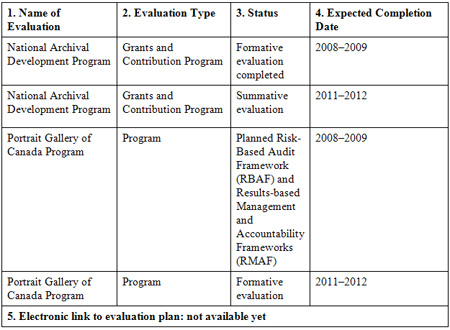
Table 6: Green Procurement
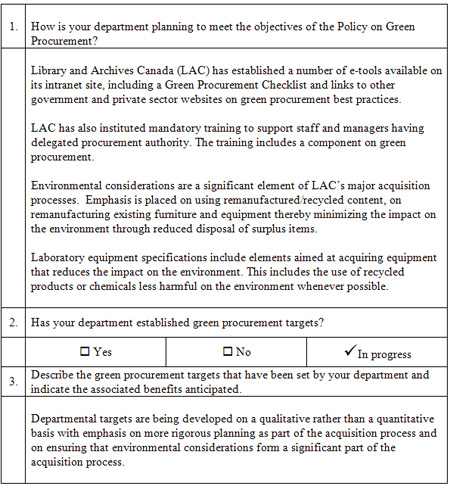
Table 8: Internal Audits
Upcoming Internal Audits (Next three fiscal years)
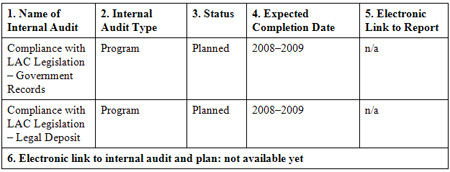
Table 10: Progress Toward the Department's Regulatory Plan
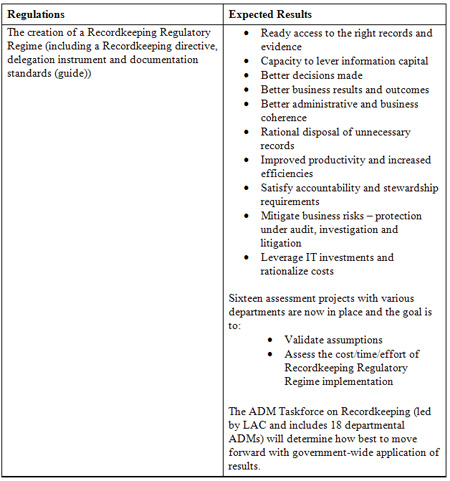
Table 12: Services Received Without Charge
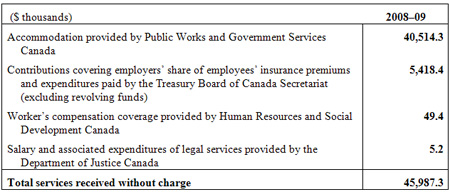
Table 13: Sources of Respendable and Non-respendable Revenue
Respendable Revenue

Non-respendable Revenue
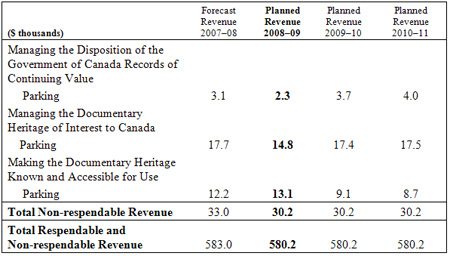
Table 14: Status Report on Major Crown Projects
Description
Project Objectives
To construct or otherwise obtain an appropriate building for the Portrait Gallery of Canada to house a range of gallery functions, including exhibitions, acquisitions and research, education and public programming.
- In June 2007, Library and Archives Canada was granted Revised PPA and specific approval for a "Redefinition" Phase of work, which would involve project planning plus the solicitation of development proposals from the private sector. It was decided that the overall Portrait Gallery building project would be managed as a Major Crown Project (MCP).
Redefinition Phase of Work
- Scope
- Solicit proposals from developers to provide a site and building for the Portrait Gallery, plus community-based financial support for the capital project and ongoing operations of the Gallery.
- Convene a selection committee, to be chaired by LAC and include representatives from the cultural/Art Gallery community and private sector.
- Evaluate submissions and prepare a recommendation to the Minister of Canadian Heritage
- Seek Government endorsement, plus Effective Project Approval from Treasury Board to permit the conclusion of legal agreements plus design-development and subsequent construction through the selected developer.
- Status
- The ministers of Canadian Heritage and PWGSC announced the revised strategy for the Portrait Gallery Building Project on November 09, 2007.
- A Request for Proposals (RFP) was released by PWGSC on November 11 through its contracting internet site, MERX.
Leading and Participating Departments
This subsection lists the participants (departments) associated with the MCP.
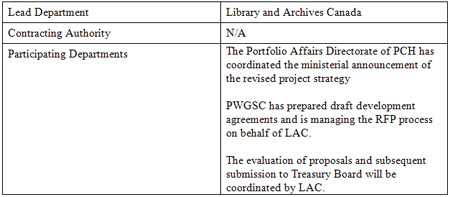
Prime and Major Subcontractor(s)
This subsection lists all contractors associated with the development of the MCP.

Major Milestones
This subsection lists the major milestones associated with the progress of the MCP.
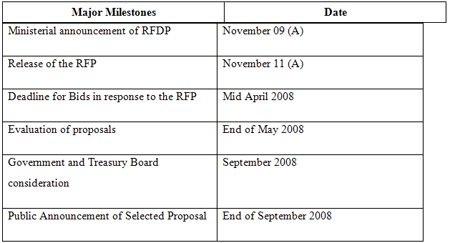
Progress Report and Explanations of Variances
An extension to the deadline for bids, in response to the RFP, is reflected in the revised milestone dates.
Industrial Benefits
The current Request for Proposals process is viewed as an opportunity for Canadian cities to host a leading cultural venue and to draw visitors from across Canada and around the world. It is an opportunity to build on vibrant arts and cultural offerings already available, and to gain a new partner in the Portrait Gallery of Canada and its parent institution, Library and Archives Canada.
Table 15: Summary of Capital Spending by Program Activity

Table 16: User Fees
